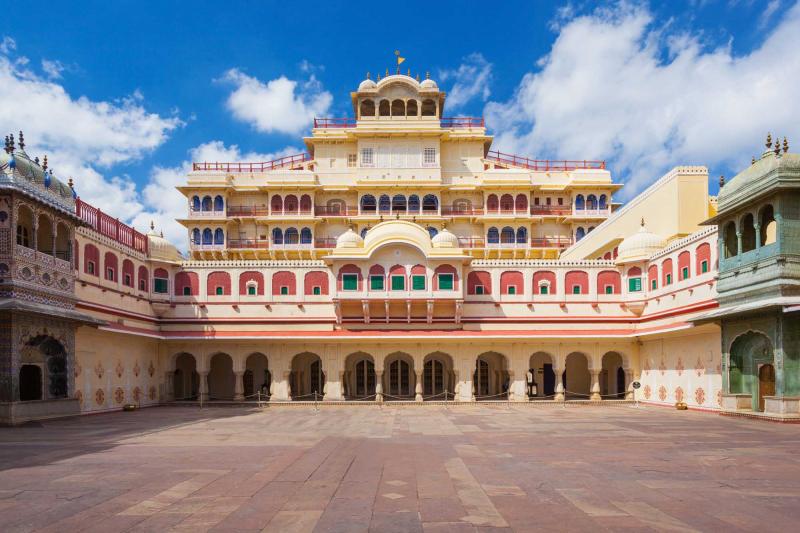Nestled in the heart of the Pink City, the City Palace of Jaipur is a timeless masterpiece that showcases Rajasthan’s regal splendor and architectural brilliance. A blend of Mughal and Rajput styles, this grand complex is not just a palace but a living piece of history. Here’s everything you need to know for your visit.
Location
City Palace is located in the heart of Jaipur, near Jantar Mantar and Hawa Mahal. Its central location makes it easily accessible from all parts of the city.
Address: Jaleb Chowk, Jaipur, Rajasthan 302002
Timings: 9:30 AM – 5:00 PM (day visit); 7:00 PM – 10:00 PM (night visit)
Entry Fees: ₹200 for Indians and ₹700 for foreign nationals (Day visit); additional charges for the museum.
How to Reach
Jaipur is well-connected by road, rail, and air. Reaching the City Palace is easy due to its central location.
By Air
The Jaipur International Airport (JAI) is about 12 km from the palace.
From the airport, hire a taxi or book an Ola/Uber for a 30-minute drive.
By Train
Jaipur Junction is the city’s main railway station, 6 km from the palace.
Auto-rickshaws, taxis, or city buses can take you directly to the site.
By Road
Regular buses, private taxis, and autos ply to the City Palace from all major parts of Jaipur.
If you’re driving, parking facilities are available near the palace entrance.
History of City Palace
Built in 1727 by Maharaja Sawai Jai Singh II, the founder of Jaipur, the City Palace served as the royal family’s residence and administrative center. Over the centuries, successive rulers expanded and enhanced the palace. It was designed as the focal point of Jaipur, ensuring the city revolved around its grandeur.
The palace also reflects Jaipur’s careful urban planning and adherence to Vastu Shastra principles. While parts of the palace are still home to the royal family, much of it has been converted into museums showcasing their heritage.
Key Attractions at City Palace
1. Mubarak Mahal (Welcome Palace)
This striking structure, built in the late 19th century by Maharaja Madho Singh II, was designed to greet royal guests. Today, it houses a museum showcasing royal textiles, including delicate silks and Kashmiri shawls.
2. Chandra Mahal
The seven-storied Chandra Mahal is the royal residence and offers panoramic views of the city. The first floor is open to visitors and showcases royal artifacts, paintings, and decorations. The upper floors are still occupied by the descendants of the royal family.
3. Diwan-i-Khas (Hall of Private Audience)
This elegant hall houses two enormous silver urns that are listed in the Guinness World Records as the largest silver vessels in the world. These urns were used by Maharaja Madho Singh II to carry water from the Ganges during his trip to England.
4. Diwan-i-Aam (Hall of Public Audience)
This hall features intricately decorated ceilings and is lined with historic manuscripts, miniature paintings, and ancient texts.
5. Pritam Niwas Chowk (Peacock Courtyard)
A photographer’s delight, this courtyard is adorned with four exquisitely painted doorways, each representing a season. The peacock motifs on the doors are particularly famous.
6. The Royal Museum
The museum houses an incredible collection of royal costumes, weapons, and antique treasures. Highlights include Maharaja Sawai Jai Singh’s astronomical instruments and royal armory dating back to the 15th century.
Interesting Facts About City Palace
The two massive silver urns in the Diwan-i-Khas weigh 340 kg each and were crafted from 14,000 melted silver coins.
City Palace is a blend of Rajput, Mughal, and European architectural styles.
The palace complex covers one-seventh of the area of Jaipur’s old city.
The gates of Pritam Niwas Chowk symbolize the four seasons: Lotus Gate (summer), Peacock Gate (autumn), Green Gate (spring), and Rose Gate (winter).
The royal family of Jaipur still resides in parts of Chandra Mahal.
Tips for First-Time Visitors
Arrive early to avoid crowds and explore the palace at a leisurely pace.
Consider hiring a local guide or renting an audio guide for a more insightful experience.
Wear comfortable footwear as there’s plenty of walking involved.
Photography is allowed in most parts of the palace, but ensure you respect restricted areas.
For a magical experience, visit during the night tour, when the palace is illuminated beautifully.
Don’t miss the souvenir shop near the exit to buy authentic Rajasthani handicrafts.
Best Time to Visit
The ideal time to visit City Palace is during October to March, as the weather is pleasant. Summers in Jaipur can be scorching, so avoid visiting during peak heat hours.
Nearby Attractions
Jantar Mantar: UNESCO World Heritage Site featuring ancient astronomical instruments.
Hawa Mahal: The iconic Palace of Winds is just a short walk away.
Albert Hall Museum: Rajasthan’s oldest museum, showcasing artifacts and artworks.
Bapu Bazaar: A bustling market famous for textiles, jewelry, and handicrafts.
The City Palace of Jaipur is not just a historical landmark; it’s a living legacy of Rajasthan’s rich culture and royal heritage. Whether you’re an architecture enthusiast, history buff, or casual traveler, this magnificent palace promises an unforgettable experience. Don’t forget to take plenty of photos and immerse yourself in the grandeur of Jaipur!

